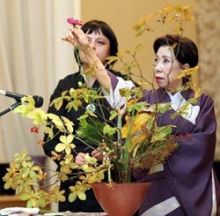Some Kyivites will soon be associating autumn, with its incredible colors, mystery, predictability, and the light sadness that is germane to this season, with Japan. It has already become a tradition for ikebana teachers to conduct master classes in Ukraine in the fall. That’s no surprise, because autumn is the season of riotous colors.
Yamada Midori, a professor of ikebana, takes a dark green leaf whose shape resembles a maple leaf and points to where a cherry red “star” has formed. “This is very beautiful. You have beautiful colors in the fall. It reminds me of the wine festival in Moldova, from which I returned yesterday. Let’s make a composition in honor of the wine festival.”
Yamada Midori is a professor of the highest — fifth-category of ikebana art, to which she has dedicated her whole life. Her nickname is Yamada Sensei (teacher). She explains that ikebana is not simply a floral composition: it must include elements of Japanese wisdom and philosophy. It is also an excursion into the history of the Land of the Rising Sun. Everything that is in the soul of the ikebana master must be revealed in the art of ikebana.
“Large compositions are not stable. Some part of them may shift or start to droop, so you have to keep working on the arrangement. But large arrangements are more beautiful. It’s the same way with women: men like strong women less than those who need help and want men to take care of them,” Yamada said, conjuring up another ikebana arrangement while keeping her eye on two boys trying to make sure that the branches of the guelder rose won’t droop and the vase does not fall.
Yamada must be one of those strong women because she spends her entire life traveling from Japan to Kyiv, Kishinev, Almaty, Moscow, and all the way to Vladivostok. “I don’t have enough energy for everything, but I must keep trying.” She heads a branch of the Ekinobo Ikebana School in the CIS and has pupils everywhere. Her Kyiv students helped her by bringing plants donated by the Fomin Botanical Gardens.
“Ladies, when someone presents you with a rose or another kind of flower, don’t simply put it in a glass (Yamada spoke Russian without an interpreter). You should find a modern vase, take two more branches so that they make up two-thirds of the composition, and create a light ikebana. Light things bring lightness to the home. And keep in mind that the highest branch is the sky, the middle one is a person, and the smallest one is the earth. These are ikebana laws that correspond to the integrity of nature, and they should be followed,” the professor of ikebana explained.
Another very important law is that everything in nature is necessary; everything has its own meaning and purpose. For example, a withered plant has seeds, so it carries future life.
The plants that Yamada used in her 10 compositions featured a variety of forms and colors. I recognized guelder roses, chrysanthemums, pines, reeds, roses, dahlias, gladioli, carnations, ferns, branches of red geranium, various dried flowers, and semi-withered leaves. But there were many flowers in the Botanical Gardens that I din’t recognize: everything brought joy to the eye and soul. “These are presents from nature and they bring happiness,” she said.
It is no simple task to create art works out of these presents from nature: not all plants are easy to break or cut with scissors. Tellingly, only men practiced the art of ikebana in Japan until the 18th century. Each element has its own meaning, transmitting a certain kind of information — everything should be taken into account. Ikebana is a complete philosophy of harmonious coexistence with nature and a book of Japanese wisdom. For her work in popularizing this art in Ukraine, the government of Japan awarded Yamada the Order of the Rising Sun.







